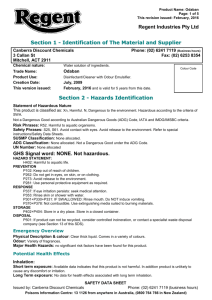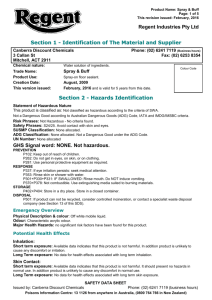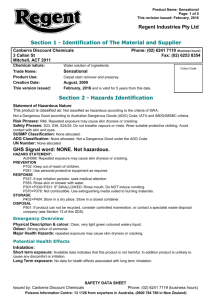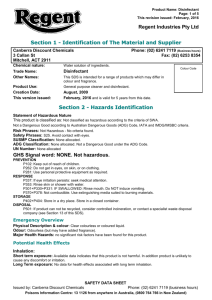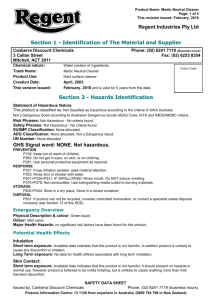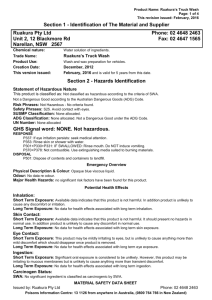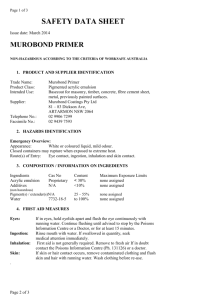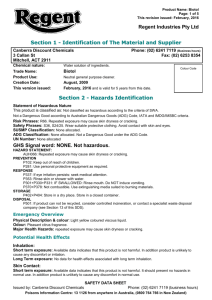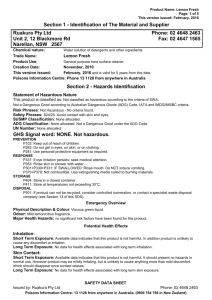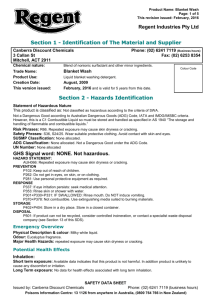Autosol® Scratch Remover
advertisement
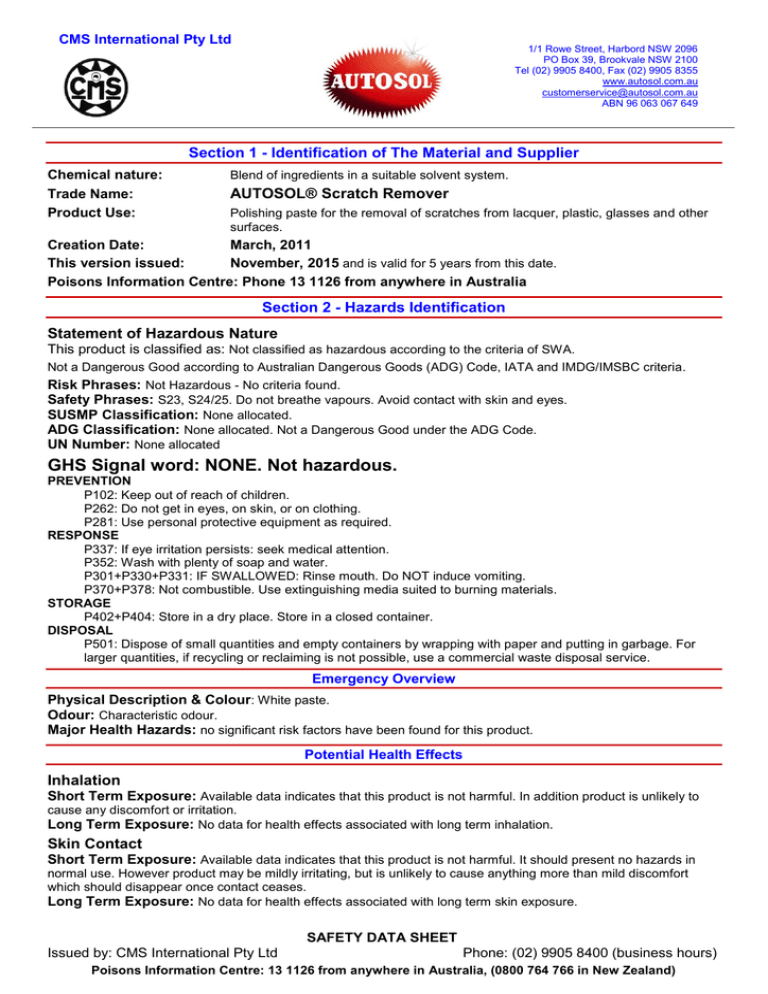
CMS International Pty Ltd 1/1 Rowe Street, Harbord NSW 2096 PO Box 39, Brookvale NSW 2100 Tel (02) 9905 8400, Fax (02) 9905 8355 www.autosol.com.au customerservice@autosol.com.au ABN 96 063 067 649 Section 1 - Identification of The Material and Supplier Chemical nature: Trade Name: Product Use: Blend of ingredients in a suitable solvent system. AUTOSOL® Scratch Remover Polishing paste for the removal of scratches from lacquer, plastic, glasses and other surfaces. Creation Date: March, 2011 This version issued: November, 2015 and is valid for 5 years from this date. Poisons Information Centre: Phone 13 1126 from anywhere in Australia Section 2 - Hazards Identification Statement of Hazardous Nature This product is classified as: Not classified as hazardous according to the criteria of SWA. Not a Dangerous Good according to Australian Dangerous Goods (ADG) Code, IATA and IMDG/IMSBC criteria. Risk Phrases: Not Hazardous - No criteria found. Safety Phrases: S23, S24/25. Do not breathe vapours. Avoid contact with skin and eyes. SUSMP Classification: None allocated. ADG Classification: None allocated. Not a Dangerous Good under the ADG Code. UN Number: None allocated GHS Signal word: NONE. Not hazardous. PREVENTION P102: Keep out of reach of children. P262: Do not get in eyes, on skin, or on clothing. P281: Use personal protective equipment as required. RESPONSE P337: If eye irritation persists: seek medical attention. P352: Wash with plenty of soap and water. P301+P330+P331: IF SWALLOWED: Rinse mouth. Do NOT induce vomiting. P370+P378: Not combustible. Use extinguishing media suited to burning materials. STORAGE P402+P404: Store in a dry place. Store in a closed container. DISPOSAL P501: Dispose of small quantities and empty containers by wrapping with paper and putting in garbage. For larger quantities, if recycling or reclaiming is not possible, use a commercial waste disposal service. Emergency Overview Physical Description & Colour: White paste. Odour: Characteristic odour. Major Health Hazards: no significant risk factors have been found for this product. Potential Health Effects Inhalation Short Term Exposure: Available data indicates that this product is not harmful. In addition product is unlikely to cause any discomfort or irritation. Long Term Exposure: No data for health effects associated with long term inhalation. Skin Contact Short Term Exposure: Available data indicates that this product is not harmful. It should present no hazards in normal use. However product may be mildly irritating, but is unlikely to cause anything more than mild discomfort which should disappear once contact ceases. Long Term Exposure: No data for health effects associated with long term skin exposure. SAFETY DATA SHEET Issued by: CMS International Pty Ltd Phone: (02) 9905 8400 (business hours) Poisons Information Centre: 13 1126 from anywhere in Australia, (0800 764 766 in New Zealand) Product Name: Autosol® Scratch Remover Page: 2 of 4 This revision issued: November, 2015 Eye Contact Short Term Exposure: This product may be irritating to eyes, but is unlikely to cause anything more than mild transient discomfort. Long Term Exposure: No data for health effects associated with long term eye exposure. Ingestion Short Term Exposure: Significant oral exposure is considered to be unlikely. However, this product may be irritating to mucous membranes but is unlikely to cause anything more than transient discomfort. Long Term Exposure: No data for health effects associated with long term ingestion. Carcinogen Status SWA: No significant ingredient is classified as carcinogenic by SWA. NTP: No significant ingredient is classified as carcinogenic by NTP. IARC: No significant ingredient is classified as carcinogenic by IARC. Section 3 - Composition/Information on Ingredients Ingredients CAS No Conc,% TWA (mg/m3) STEL (mg/m3) Kerosene 8008-20-6 10-40 not set not set Other non hazardous ingredients various to 100 not set not set This is a commercial product whose exact ratio of components may vary slightly. Minor quantities of other non hazardous ingredients are also possible. The SWA TWA exposure value is the average airborne concentration of a particular substance when calculated over a normal 8 hour working day for a 5 day working week. The STEL (Short Term Exposure Limit) is an exposure value that may be equalled (but should not be exceeded) for no longer than 15 minutes and should not be repeated more than 4 times per day. There should be at least 60 minutes between successive exposures at the STEL. The term "peak "is used when the TWA limit, because of the rapid action of the substance, should never be exceeded, even briefly. Section 4 - First Aid Measures General Information: You should call The Poisons Information Centre if you feel that you may have been poisoned, burned or irritated by this product. The number is 13 1126 from anywhere in Australia (0800 764 766 in New Zealand) and is available at all times. Have this SDS with you when you call. Inhalation: First aid is not generally required. If in doubt, contact a Poisons Information Centre or a doctor. Skin Contact: Gently brush away excess particles. Irritation is unlikely. However, if irritation does occur, flush with lukewarm, gently flowing water for 5 minutes or until chemical is removed. Eye Contact: Quickly and gently brush particles from eyes. No effects expected. If irritation does occur, flush contaminated eye(s) with lukewarm, gently flowing water for 5 minutes or until the product is removed. Obtain medical advice if irritation becomes painful or lasts more than a few minutes. Take special care if exposed person is wearing contact lenses. Ingestion: If product is swallowed or gets in mouth, do NOT induce vomiting; wash mouth with water and give some water to drink. If symptoms develop, or if in doubt contact a Poisons Information Centre or a doctor. Section 5 - Fire Fighting Measures Fire and Explosion Hazards: The major hazard in fires is usually inhalation of heated and toxic or oxygen deficient (or both), fire gases. There is little risk of an explosion from this product if commercial quantities are involved in a fire. Vapours from this product are heavier than air and may accumulate in sumps, pits and other low-lying spaces, forming potentially explosive mixtures. They may also flash back considerable distances. Fire decomposition products from this product may be toxic if inhaled. Take appropriate protective measures. Extinguishing Media: Suitable extinguishing media are carbon dioxide, dry chemical, foam, water fog. Fire Fighting: If a significant quantity of this product is involved in a fire, call the fire brigade. Cool closed, undamaged containers exposed to fire with water spray. Flash point: >100°C Upper Flammability Limit: No data. Lower Flammability Limit: No data. Autoignition temperature: No data. Flammability Class: Combustible solid. Section 6 - Accidental Release Measures Accidental release: This product is sold in small packages, and the accidental release from one of these is not usually a cause for concern. For minor spills, clean up, rinsing to sewer and put empty container in garbage. Although SAFETY DATA SHEET Issued by: CMS International Pty Ltd Phone: (02) 9905 8400 (business hours) Poisons Information Centre: 13 1126 from anywhere in Australia, (0800 764 766 in New Zealand) Product Name: Autosol® Scratch Remover Page: 3 of 4 This revision issued: November, 2015 no special protective clothing is normally necessary because of occasional minor contact with this product, it is good practice to wear impermeable gloves when handling chemical products. In the event of a major spill, prevent spillage from entering drains or water courses and call emergency services. Section 7 - Handling and Storage Handling: Keep exposure to this product to a minimum, and minimise the quantities kept in work areas. Check Section 8 of this SDS for details of personal protective measures, and make sure that those measures are followed. The measures detailed below under "Storage" should be followed during handling in order to minimise risks to persons using the product in the workplace. Also, avoid contact or contamination of product with incompatible materials listed in Section 10. Storage: Store packages of this product in a cool place. Make sure that containers of this product are kept tightly closed. Keep containers dry and away from water. Keep containers of this product in a well ventilated area. Make sure that the product does not come into contact with substances listed under "Incompatibilities" in Section 10. Check packaging - there may be further storage instructions on the label. Section 8 - Exposure Controls and Personal Protection The following Australian Standards will provide general advice regarding safety clothing and equipment: Respiratory equipment: AS/NZS 1715, Protective Gloves: AS 2161, Occupational Protective Clothing: AS/NZS 4501 set 2008, Industrial Eye Protection: AS1336 and AS/NZS 1337, Occupational Protective Footwear: AS/NZS2210. SWA Exposure Limits TWA (mg/m3) STEL (mg/m3) Exposure limits have not been established by SWA for any of the significant ingredients in this product. No special equipment is usually needed when occasionally handling small quantities. The following instructions are for bulk handling or where regular exposure in an occupational setting occurs without proper containment systems. Ventilation: This product should only be used in a well ventilated area. If natural ventilation is inadequate, use of a fan is suggested. Eye Protection: Eye protection such as protective glasses or goggles is recommended when product is being used. Skin Protection: The information at hand indicates that this product is not harmful and that normally no special skin protection is necessary. However, we suggest that you routinely avoid contact with all chemical products and that you wear suitable gloves (preferably elbow-length) when skin contact is likely. Protective Material Types: There is no specific recommendation for any particular protective material type. Respirator: If there is a significant chance that dusts are likely to build up in the area where this product is being used, we recommend that you use a suitable Dust Mask. Section 9 - Physical and Chemical Properties: Physical Description & colour: Odour: Boiling Point: Freezing/Melting Point: Volatiles: Vapour Pressure: Vapour Density: Specific Gravity: Water Solubility: pH: Volatility: Odour Threshold: Evaporation Rate: Coeff Oil/water Distribution: Viscosity: Autoignition temp: White paste. Characteristic odour. Not available. No specific data. Solid at normal temperatures. No data. No data. Not applicable. 1.1 approx Insoluble. 8.5 as supplied; 9.0 (10% in water) No data. No data. Not applicable. No data Approx 1400mPas at 20°C (DIN 53211); >7mm 2/s at 40°C No data. Section 10 - Stability and Reactivity Reactivity: This product is unlikely to react or decompose under normal storage conditions. However, if you have any doubts, contact the supplier for advice on shelf life properties. Conditions to Avoid: This product should be kept in a cool place, preferably below 30°C. Keep containers tightly closed. Containers should be kept dry. Keep containers and surrounding areas well ventilated. Incompatibilities: strong acids, strong bases, strong oxidising agents. SAFETY DATA SHEET Issued by: CMS International Pty Ltd Phone: (02) 9905 8400 (business hours) Poisons Information Centre: 13 1126 from anywhere in Australia, (0800 764 766 in New Zealand) Product Name: Autosol® Scratch Remover Page: 4 of 4 This revision issued: November, 2015 Fire Decomposition: Combustion forms carbon dioxide, and if incomplete, carbon monoxide and smoke. Water is also formed. Carbon monoxide poisoning produces headache, weakness, nausea, dizziness, confusion, dimness of vision, disturbance of judgment, and unconsciousness followed by coma and death. Polymerisation: This product will not undergo polymerisation reactions. Section 11 - Toxicological Information Local Effects: Target Organs: There is no data to hand indicating any particular target organs. Classification of Hazardous Ingredients Ingredient Risk Phrases No ingredient mentioned in the HSIS Database is present in this product at hazardous concentrations. Section 12 - Ecological Information This product is not readily biodegradable. However, likely to degrade slowly in the soil or water and not cause long term problems. Expected to not be an environmental hazard. Section 13 - Disposal Considerations Disposal: Dispose of small quantities and empty containers by wrapping with paper and putting in garbage. For larger quantities, if recycling or reclaiming is not possible, use a commercial waste disposal service. Section 14 - Transport Information UN Number: This product is not classified as a Dangerous Good by ADG, IATA or IMDG/IMSBC criteria. No special transport conditions are necessary unless required by other regulations. Section 15 - Regulatory Information AICS: All of the significant ingredients in this formulation are compliant with NICNAS regulations. The following ingredient: Kerosene (as liquid hydrocarbon), is mentioned in the SUSMP. Section 16 - Other Information This SDS contains only safety-related information. For other data see product literature. Acronyms: ADG Code AICS SWA CAS number IARC NTP R-Phrase SUSMP UN Number Australian Code for the Transport of Dangerous Goods by Road and Rail (7th edition) Australian Inventory of Chemical Substances Safe Work Australia, formerly ASCC and NOHSC Chemical Abstracts Service Registry Number International Agency for Research on Cancer National Toxicology Program (USA) Risk Phrase Standard for the Uniform Scheduling of Medicines & Poisons United Nations Number THIS SDS SUMMARISES OUR BEST KNOWLEDGE OF THE HEALTH AND SAFETY HAZARD INFORMATION OF THE PRODUCT AND HOW TO SAFELY HANDLE AND USE THE PRODUCT IN THE WORKPLACE. EACH USER MUST REVIEW THIS SDS IN THE CONTEXT OF HOW THE PRODUCT WILL BE HANDLED AND USED IN THE WORKPLACE. IF CLARIFICATION OR FURTHER INFORMATION IS NEEDED TO ENSURE THAT AN APPROPRIATE RISK ASSESSMENT CAN BE MADE, THE USER SHOULD CONTACT THIS COMPANY SO WE CAN ATTEMPT TO OBTAIN ADDITIONAL INFORMATION FROM OUR SUPPLIERS OUR RESPONSIBILITY FOR PRODUCTS SOLD IS SUBJECT TO OUR STANDARD TERMS AND CONDITIONS, A COPY OF WHICH IS SENT TO OUR CUSTOMERS AND IS ALSO AVAILABLE ON REQUEST. Please read all labels carefully before using product. This SDS is prepared in accord with the SWA document “Preparation of Safety Data Sheets for Hazardous Chemicals - Code of Practice” (December 2011) Copyright © Kilford & Kilford Pty Ltd, November, 2015. http://www.kilford.com.au/ Phone (02)9251 4532 SAFETY DATA SHEET Issued by: CMS International Pty Ltd Phone: (02) 9905 8400 (business hours) Poisons Information Centre: 13 1126 from anywhere in Australia, (0800 764 766 in New Zealand)
